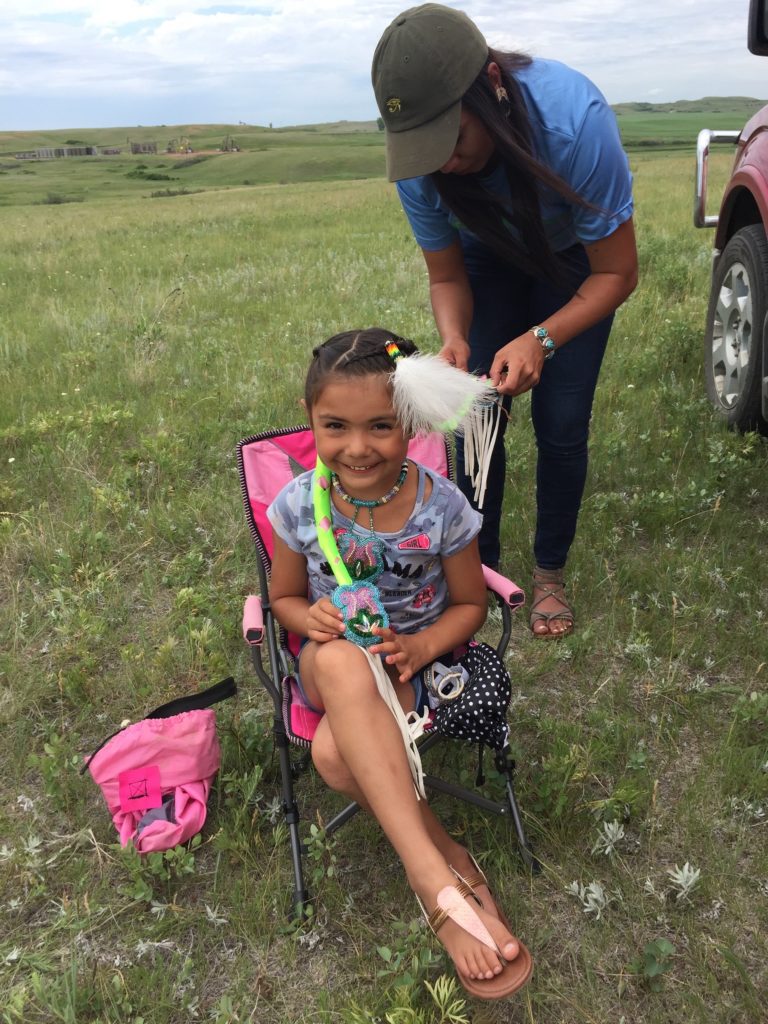Braiding Ribbons
The mother covered the long black braids with a weave of pink and green ribbons. She started with the green ribbon from the point where the braid descends from the girl’s small head all the way to the tiny tips of the ponytail. At the bottom, she tied a tight knot, then started weaving the pink ribbon crisscrossing over the green ribbon until none of the girl’s braided dark hair was exposed.

The mother asked her daughter, “Why do you like to dance?
Without moving her head, the five-year-old said,
“I dance to honor my people, my traditions, and mother earth.”
The mother moved around to the front of the folding chair where her daughter was sitting and kneeled in the tall green grass. She sat eye-level with her daughter. The little pink canvas chair was inches from the door of a red Ford F150 4 x 4 pick up parked on the slope of a field in the middle of the North Dakota prairie.
Her mother said, “And what do we say?” The girl knew that her mother was testing her? She hesitated because she wanted to get it right. The girl knew the answer? It was right at the tip of her tongue. But she waited.
The sky was big; the clouds stretched their arms around the green grass below, holding time and space for this moment, holding time and space for the little sat cross-legged child. The sky also held time and space for the young mother.
The girl had long thin legs, brown and bruised from her summer play. But, she loved being outdoors, she told me.
“Also, in the winter?” I ask.
“No,” she said, “I could freeze to death.”
The wind was calm, the sky a cornflower blue, the sun hot when it peaked through the paint brushed white laughing clouds. The girl’s left leg was swinging back and forth as it hung over her right knee. The girl seemed full of excitement that spilled out of her and over the wildflower field.
On her feet were golden sandals, fit for a little princess. Her eyes were dark brown, attentive, searching for focus, waiting to engage with her mother.
She understood her role as the inheritor of the ways of a proud people. She knew what will be demanded of her. She knew she had to make her mother proud. And, she knew she could do it.
The palm-sized beaded necklace, blue and green, a scene of sky and hills, hung heavy on her tiny neck. It hung like those responsibilities she has as a descendent.
A pencil lay next to her right foot, next to the eagle sage, the holy cleansing sage of her native prairie people. She wanted to learn everything about this place, about its nature, and about living on the spot where the hills roll over her dreams at night.
She knew she must learn before it is forgotten before the land is killed by the hand of the takers. The greed is all around her now. The takers had come to lift black gold from deep below the surface. She must learn everything to know before the air is too thick with black soot of toxic flames that shot into the prairie sky –

– and before the day when the water will be too poisoned, and the fish are gone.
She loves the fish. She waited at the edge of the lake for them to come to her when she called them. She caught the fish after she greeted them and asked them if it was OK for her to take them from their place in the water. She couldn’t imagine a world without her fish.
Her mother stared at her, smiled, and asked again, “You know what we say? Don’t you?”
The girl lifted her tiny brown right fist in the air and whispered, “Mni Wiconi,” and her mother asked, “And what does that mean”?
The girl stared straight into her mother’s dark loving eyes and waited.
The little girl’s mouth open ready to say something, as she lifted her left hand and placed it on her kneeling mother’s right shoulder and said out loud, “Water is life.”
The girl knew what she had to do. The mother was proud.
More about Ashly Hall and the – Descendants Alliance.
More about Water is Life and the movement.
Voices. Values. Identities.

